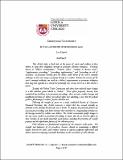| dc.description.abstract |
This Article takes a fresh look at the power of courts and creditors to force debtors to repay their obligations through in personam collection techniques. Variously known as “debtors’ examinations,” “turnover orders,” “citations to discover assets,” “supplementary proceedings,” “proceedings supplementary.” And “proceedings in aid of execution,” in personam remedies force the debtor, under threat of the court’s contempt authority, to turn over money or property directly to a creditor. Because the exercise of the court’s contempt authority can result in a debtor’s imprisonment, in personam techniques have long been regarded as a critical but potentially very coercive arrow in a debt collector’s quiver. This Article recommends specific changes to the way courts conduct in personam proceedings to ensure that in terrorem effects of these remedies do not upend important social policies, including the protection of exempt property and the adjudicative fairness of the collection process. |

